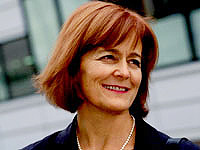

Keynote Speech
|
Learning How to Dance Using a 3D Webplatform Prof. Nadia Magnenat-Thalmann MIRALab - University of Geneva E-Mail: thalmann@miralab.unige.ch Until recently dance was part of the physical education programme in many countries. It is now recognised as an art form comparable to music, drama, and visual arts and equally worthy of study. The reasons include the lack of appropriate teaching resources that enable teachers/trainers to provide an integrated view of the movement and social aspects of dance as the limited use of new media that improve the attractiveness of dance resources to students. We will present in this talk the WebDance European project and more particularly our contribution in 3D and Web technologies to create motion captured dances and a web 3D platform. In the project WebDance, we can show, on the web, 3D simulation of various dances that allows teachers and trainers to use our platform to document traditional dance ,understand in 3D how dancers are performing their art and later on, create dance lessons. The long term objective is also to create an online dance learning community. Our web based application displays dance animations embedded in a web site. Currently, web based 3D applications are not heavily developed due to web limitations. But the combination between actual 3D engines and web technologies in terms of interface could provide acceptable 3D visualization. The most actual popular web browsers are Internet Explorer (www.microsoft.com) and FireFox (www.mozilla.com). Theses webbrowsers do not integrate any 3D engines yet. That is why we use it like an application container and we create dedicated plug-in. The graphics part is managed in a specific coding language (C++ is the most popular for computer graphics) and it is wrapped by the component interface. Mainly, the current component interfaces are coded in C++ and are called ActiveX in the Internet Explorer case and XPCOM in the FireFox case. Each one is designed to manage and interpret C++ coding. Consequently this application is coding into three parts, one is the core of the application and the two others are dedicated to interface web browzer and the application core. Examples of how to learn through this platform will be shown. Biography:  From 1977 to 1989, she was a Professor at the University of Montreal where she founded the research lab MIRALab. She was elected Woman of the Year in the Grand Montreal for her pionnering work on virtual humans and presented Virtual Marilyn at the Modern Art Museum of New York in 1988. Since 1989, she is Professor at the University of Geneva where she recreated the interdisciplinary MIRALab laboratory. With her 30 PhD students, she has authored and coauthored more than 300 research papers and books in the field of modeling virtual humans, interacting with them and living in augmented worlds. She is presently taking part in more than a dozen of European and National Swiss research projects and she is the Coordinator of several European Research Projects as the Network of Excellence (NoE) INTERMEDIA, the Project HAPTEX and the European Research training Network Marie Curie 3D ANATOMICAL HUMANS. She is coordinating the Virtual Campus Swiss project "Understanding 3D" and is working also for the European Project Webdance. She is editor-in-chief of the Visual Computer Journal published by Springer Verlag and co-editor-in-chief of the journal Computer Animation and Virtual Worlds published by Wiley. She also participated to political events as to the WORLD ECONOMIC FORUM in DAVOS where she was invited to give several talks and seminars on the importance of multimedia for society. |
|
Copyright (C) 2007 ICWL Committee. All right reserved.





